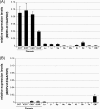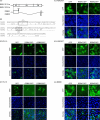Identification of novel endogenous betaretroviruses which are transcribed in the bovine placenta
- PMID: 21084469
- PMCID: PMC3020495
- DOI: 10.1128/JVI.01234-10
Identification of novel endogenous betaretroviruses which are transcribed in the bovine placenta
Abstract
Sequences of retroviral origin occupy approximately 10% of mammalian genomes. Various infectious endogenous retroviruses (ERVs) and functional retroviral elements have been reported for several mammals but not cattle. Here, we identified two proviruses, designated bovine endogenous retrovirus K1 (BERV-K1) and BERV-K2, containing full-length envelope (env) genes in the bovine genome. Phylogenetic analysis revealed that they belong to the genus Betaretrovirus. By reverse transcription (RT)-PCR, both BERV-K1 and -K2 env mRNAs were detected in the placenta and cultured bovine trophoblast cells. Real-time RT-PCR analysis using RNAs isolated from various bovine tissues revealed that BERV-K1 env mRNA was preferentially expressed in the placenta. Moreover, we also found the expression of doubly spliced transcripts, named the REBK1 and REBK2 genes. Both the REBK1 and REBK2 proteins have motifs for a putative nuclear localization signal and a nuclear export signal. REBK1 and REBK2 fused with green fluorescent proteins were localized mainly in the nuclei when they were expressed in bovine and porcine cells. In the env and 3' long terminal repeats of BERV-K1 and -K2, we found regulatory elements responsible for the splicing and transport of viral RNAs and/or translation of the env genes. Although we have not identified the expressed Env proteins in bovine tissues, these data suggest that both BERV-K1 and BERV-K2 express Env proteins and that these proteins may have physiological functions in vivo.
Figures







Similar articles
-
Bovine trophoblastic cell differentiation and binucleation involves enhanced endogenous retrovirus element expression.Reprod Biol Endocrinol. 2012 May 25;10:41. doi: 10.1186/1477-7827-10-41. Reprod Biol Endocrinol. 2012. PMID: 22632112 Free PMC article.
-
Recent advances in the study of active endogenous retrovirus envelope glycoproteins in the mammalian placenta.Virol Sin. 2015 Aug;30(4):239-48. doi: 10.1007/s12250-015-3617-0. Epub 2015 Aug 18. Virol Sin. 2015. PMID: 26311491 Free PMC article. Review.
-
Dysfunction of bovine endogenous retrovirus K2 envelope glycoprotein is related to unsuccessful intracellular trafficking.J Virol. 2014 Jun;88(12):6896-905. doi: 10.1128/JVI.00288-14. Epub 2014 Apr 2. J Virol. 2014. PMID: 24696495 Free PMC article.
-
Characterization of the bovine endogenous retrovirus beta3 genome.Mol Cells. 2008 Feb 29;25(1):142-7. Mol Cells. 2008. PMID: 18319627
-
Evidence for expression of endogenous retroviral sequences on primate reproductive tissues and detection of cross-reactive ERVS antigens in the baboon ovary: a review.East Afr Med J. 2006 Feb;83(2):106-12. doi: 10.4314/eamj.v83i2.9397. East Afr Med J. 2006. PMID: 16708883 Review.
Cited by
-
Dynamic evolution of endogenous retrovirus-derived genes expressed in bovine conceptuses during the period of placentation.Genome Biol Evol. 2013;5(2):296-306. doi: 10.1093/gbe/evt007. Genome Biol Evol. 2013. PMID: 23335121 Free PMC article.
-
Bovine trophoblastic cell differentiation and binucleation involves enhanced endogenous retrovirus element expression.Reprod Biol Endocrinol. 2012 May 25;10:41. doi: 10.1186/1477-7827-10-41. Reprod Biol Endocrinol. 2012. PMID: 22632112 Free PMC article.
-
Endogenous Retroviruses and Placental Evolution, Development, and Diversity.Cells. 2022 Aug 8;11(15):2458. doi: 10.3390/cells11152458. Cells. 2022. PMID: 35954303 Free PMC article. Review.
-
Recent advances in the study of active endogenous retrovirus envelope glycoproteins in the mammalian placenta.Virol Sin. 2015 Aug;30(4):239-48. doi: 10.1007/s12250-015-3617-0. Epub 2015 Aug 18. Virol Sin. 2015. PMID: 26311491 Free PMC article. Review.
-
High Expression of Endogenous Retroviral Envelope Gene in the Equine Fetal Part of the Placenta.PLoS One. 2016 May 13;11(5):e0155603. doi: 10.1371/journal.pone.0155603. eCollection 2016. PLoS One. 2016. PMID: 27176223 Free PMC article.
References
-
- Cullen, B. R. 2003. Nuclear mRNA export: insights from virology. Trends Biochem. Sci. 28:419-424. - PubMed
Publication types
MeSH terms
Substances
Associated data
- Actions
- Actions
- Actions
- Actions
LinkOut - more resources
Full Text Sources
Molecular Biology Databases

